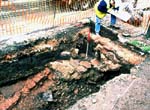| |

The town wall

Recording the town wall

The footings of the early 19th century leadworks |
|
|
An evaluation excavation was followed by a larger
excavation prior to redevelopment of the site, which lies
adjacent to the line of the medieval town wall and
downhill from the centre of the town. The town wall was
found surviving to a height of 2.3m just below the modern
ground surface.
A deep sequence of late Saxon sedimentary deposits was
found 3m below ground level including pottery, bone and
metalworking wastes. The sedimentary sequence continued
until the 13th century, just after the town wall was
built. The area was then covered in a deep spread of
landfill, during which a wall was constructed along the
St. Julian's Friars frontage separating the plot from the
street. In the later medieval and early post medieval
period the site was probably simply garden areas for
houses on the Beeches Lane frontage.
Work on analysing the results is still in progress. The
finds assemblage includes an important suite of Saxon and
medieval material with remarkably little disturbance of
the earlier deposits by later activity.
Analysis of the pottery, bone and metalworking wastes
will, in conjunction with careful selection of samples
for environmental analysis, have much to say about the
development of this part of Shrewsbury. The focus will be
on the Saxon and medieval periods. Analysis of the
various elements will greatly increase an understanding
of the diet, economy, environment and trade connections
in these periods.
The metalworking evidence is of particular interest as
Shrewsbury lies close to the iron working cradle of the
Industrial Revolution. It is important to investigate the
origin of the iron ore in order to determine any
connection with the Ironbridge/Coalbrookdale area and to
place the iron working within its regional context.
As the Saxon period is almost entirely undocumented this
site affords a very rare opportunity to investigate the
daily conditions of the inhabitants of early Shrewsbury.
|



